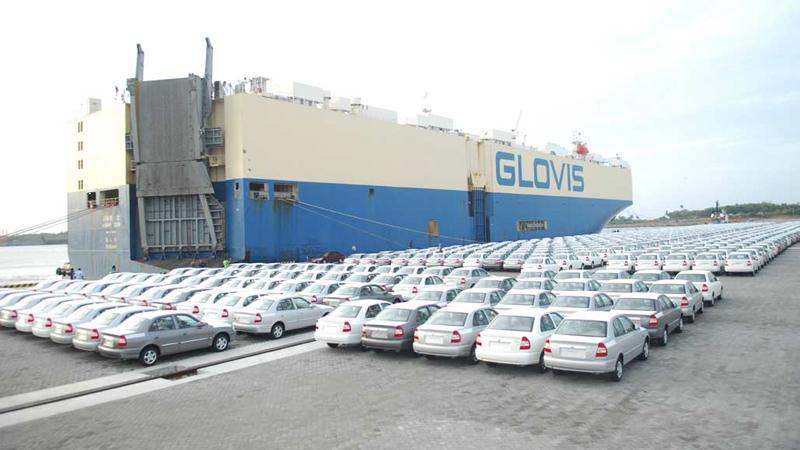
With moves to shift the car transshipment operations from Hambantota to the Colombo Port vehicle merchants and shipping experts are of the view that the pros and cons of the move should be weighed thoroughly with wide consultation prior to embarking on a major logistical and operational shift in transshipment business.
Plans are on the cards to shift the car transshipment business from Hambantota to the Colombo Port by the Ministry of Ports and Shipping with the Sri Lanka Ports Authority (SLPA) to facilitate an effective operation to attract more business that would generate more revenue to the country.
However, according to vehicle merchants and their associations there are two sides to the proposed move of shifting vehicle transshipment to Colombo.
 Operationally, Hambantota Port is preferred over Colombo, which lacks the system and adequate space for vehicle transshipment operations. Considering logistics such as transportation cost to bring down vehicles to Colombo, Hambantota is not beneficial to importers.
Operationally, Hambantota Port is preferred over Colombo, which lacks the system and adequate space for vehicle transshipment operations. Considering logistics such as transportation cost to bring down vehicles to Colombo, Hambantota is not beneficial to importers.
Vehicle Importers’ Association of Lanka (VIAL) President Indika Sampath Merenchige said that considering the cost factor on transportation, shifting the operations to Colombo is a sound move but the system for an effective business must be put in place prior to commencing transshipment in Colombo.
“We have submitted proposals to the authorities to carryout an effective vehicle transshipment operation in the Colombo Port and VIAL has received a favourable response from the Minister of Ports and Shipping Mahinda Samarasinghe,” Merenchige said.
VIAL proposes that the same practice as in Hambantota for releasing vehicles after a physical inspection by a separate Customs Unit with a Deputy Director of Customs (DDC) be adhered in Colombo.
The Association requests that the seven day no rent facility for demurrage granted at Hambantota to be continued in Colombo as well and apply the same formula for assessing demurrage in Hambantota in Colombo.
It also proposes that a yard be set up in the Colombo Port for storing vehicles to avoid pilferage and damages while shifting. VIAL recommends that the same vehicle inventory system which is already in operation in Hambantota be implemented in Colombo by issuing a triplicate paper inventory for each vehicle.

Installing a fuel station at the port, issuing two passes for importers who are members of the Association with the consent of VIAL, to follow the practice of vehicle clearance on Saturdays as in Hambantota and setting up a customs yard for vehicles detained for Customs investigations are some of the other proposals of the Association.
Merenchige said that Minister Samarasinghe had pledged during a meeting with the Association that a viable solution will be found to the issues in shifting the operations to Colombo with a wide consultation involving all stakeholders of the industry.
A study on vehicle transshipment in the Colombo Port reveals that the port is unable to handle much vehicle transshipment due to the priority given to container transshipment.
Therefore as a measure to ease the long berthing delays faced by car carriers at the port, SLPA had to route all vehicles to Hambantota.

According to the study, a transshipment hub port is determined by not only a single factor but a combination of factors such as location, cost, infrastructure, other services provided by port, port safety, man power, port connectivity, hinterland accessibility and port efficiency. Ceylon Motor Traders Association former Chairman and Sathosa Motors PLC. Managing Director/CEO Tilak Gunasekera said that the plan to shift vehicle transshipment to Colombo is a good move that will save transportation costs and clearance time which could be brought down from around four days in Hambantota to two days. He said the congestion issue was created by the former government as an excuse to take the transshipment business to Hambantota which resulted in massive costs to importers.
“It is a right move now that the Chinese have come to the scene at Hambantota to move transshipment of vehicles to Colombo which will make operations at the Colombo port efficient and cost saving,” Gunasekera said. AMW (Pvt) Ltd. Managing Director Samantha Rajapaksa said that the Colombo Port has a space crunch problem limiting its capacity to handle the car transshipment business. However, he said that authorities would have studied and taken into account the pros and cons of moving the vehicle transshipment business to Colombo prior to proposing the course of action.
“Sri Lanka is strategically located and transshipment business is definitely a very attractive revenue source for the country,” he said.
Meanwhile, vehicle merchants said that vehicle imports has dropped by around 65 percent due to the Loan to Value (LTV) ratio being low and unfavourable to buyers.
The LTV ratio was revised to 50 from 70 percent at the last budget affecting sales of cars and vans. Vehicle importers said that they had felt the buying power of customers had dropped drastically due to the high interest rates and the low LTV ratio.
VIAL has proposed tax concessions for vehicle importers at the next budget enabling people to purchase a vehicle at an affordable price.
“We have requested the authorities to reconsider the tax on electric vehicles which was raised from 5 to 50 percent and raise the LTV to 70 percent. Increasing taxes on electric vehicles is not a good move as many western countries grant concessions encouraging the use of electric vehicles which are environment friendly and cheaper,” Merenchige said.
He said concessions should be given to electric vehicle usage and taxes such as the city tax imposed like in certain countries to discourage fuel driven vehicles.
